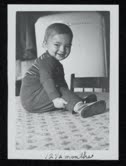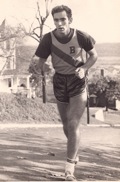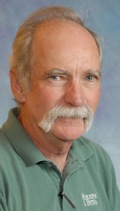Richard Benyo
Rich Benyo was born on April 20, 1946, which that year happened to be Easter Saturday. The family legend has it that his mother, Dorothy, was shelling hard-boiled eggs that had cracked and were no good to be colored for Easter, and ate several of the damaged eggs. She developed a stomachache and thought it was the result of too many eggs, when it was due to her impatient son, who wanted to come out to join the Easter parade. When he emerged from the womb, Richard Stephen Benyo joined a rogue's gallery of people born on April 20: Mohammed (570), Napoleon (1808), Adolph Hitler (1889), Harold Lloyd (1894), and Johnny Tillotson (1939). April 20 would also evolve into something of a marijuana-fused holiday; Rich claims he had nothing to do with that.
When he was five, Rich developed tonsilitis. Palmerton Hospital, where he was born, was apparently having a 2-for-1 sale, because his parents took both him and kid brother Drew (who did not have tonsilitis) to have their tonsils removed. It didn't go well for either of the boys. Halfway through his tonsil removal, Rich woke from the ether anesthesia in order to enjoy the experience first-hand of the surgeon pushing metal instruments down his throat and subsequently developed a professional-grade stuttering problem, while brother Drew nearly bled to death when the bleeding in his throat would not stop. The two of them spent a pretty miserable night in side-by-side beds, weeping and whimpering through the night, and ignoring the comic books (Little Lulu, Scrooge McDuck, etc.) they were given as a bribe to enjoy the experience.
There may have been something in the water on the lower blocks of South Street, because almost every kid that was born between 1946 and 1950 was of the male species. Hence the development of The South Street Gang: a dozen gnarly kids, including one tomboy, who roamed the mountainside and terrorized the neighborhoods for several years.
Rich and his brother Drew were introduced to books early on by Dear Old Mom, who taught them to read when they were three: well before they trudged off to St. Joseph's Parochial School in East Mauch Chunk in the early '50s. No kindergarten for kids in those days; just jump into it and start paddling. They were encouraged in their reading habits by a lady who lived on the same block and worked at the local 5 & dime store and who, every other Friday after receiving her paycheck, used her employee discount to buy a Little Golden Book for the brothers; she delivered it to their house and did the first read-throug to get them started. As a result, both of the boys gave into the habit of book hording early on and are still victims.
Turning to science-fiction in high school, Rich started several sf fanzines, after getting into the habit of reading three or four sf paperbacks a week. The first was Galactic Outpost, where, in the second issue, he was able, through a wide series of correspondence with sf authors, to solicit from Philip K. Dick an unpublished short story, "War with the Fnools." Four years later it was published in Galaxy Magazine, and it was eventually anthologized in The Collected Stories of Philip K. Dick, Volume 5.
While attending Bloomsburg State College (1964-68), Rich was first a columnist for the weekly newspaper, and eventually editor. He graduated with a BA in English lit. Immediately after graduation he went to work at the Times-News in Lehighton, Penna., a daily p.m. newspaper, starting as associate editor and quickly moving up to managing editor. During the four and a half years at the Times-News, he created Saturday Magazine, a weekend supplement to the newspaper, and served as that magazine's columnist, from which, in 1971 he won first place award for local column from the Pennsylvania Newspaper Publishers Association.
While at the Times-News he began to write occasional free-lance pieces for various magazines, including many for Stock Car Racing Magazine, where, in 1972, he was offered the editorship. He moved to the SCR offices in Alexandria, Virginia, and spent four and a half years editing the magazine. While there, he wrote his first book, Superspeedway, a chronicle of the chain of NASCAR tracks, anchored by the racing during the 1976 NASCAR Grand National season.
While at SCR, he managed to earn 40% of a master's degree in American lit at George Mason University before leaving for California in August of 1977 to accept a job as managing editor of Runner's World magazine. (He had run cross-country in college, but during his first two journalism jobs, added on an uncomfortable amount of weight, reaching 207 pounds in 1977. To prepare for the job with Runner's World, he stopped eating lunch and began a running program. He ran his first marathon in April of 1978.)
Settled in at Runner's World, he wrote a combination memoir/advice book, Return to Running. In the early 1980s he collaborated with Rhonda Provost to write two fitness books: The Indoor Exercise Book (1980) and The Advanced Indoor Exercise Book (1981), both for Anderson World Publishers. In 1983 he wrote Masters of the Marathon for Atheneum, a collection of a dozen profiles of accomplished marathon runners.
At Runner's World, he was promoted to executive editor and vice-president, publications. One of his innovations was to create a quarterly publication, Marathoner, that extensively covered marathon running. He also oversaw both book divisions. Additionally, he was involved in the creation of Get Fit, a monthly magazine devoted to women's fitness. He resigned from Runner's World in late 1984, just before it was sold to Rodale Publications in Pennsylvania.
From 1985 he did extensive free-lance writing, including a weekly running and fitness column for the San Francisco Chronicle, which ran until 1990. He also wrote for a number of magazines, including Popular Computing and Sport. He also wrote two long fact articles for The New Yorker, one on a footrace in Death Valley and the other on the Napa Valley Wine Train, where both were paid for but neither was ever printed.
In 1986 he collaborated with Elaine LaLanne, Jack LaLanne's wife, on the first of five fitness books: Fitness After 50. That was followed by Dynastride (1988), Fitness After 50 Workout (1989), Eating Right for a New You (1992), and Total Juicing (1992). He also collaborated again with Rhonda Provost, in writing Feeling Fit in Your 40s for Atheneum in 1987.
In 1989 he wrote the first of a handful of books for Human Kinetics, The Exercise Fix. That was followed by Running Past 50 (1998), The Running Encyclopedia (2001) in collaboration with Joe Henderson, and Timeless Running Wisdom (2010).
In 1991 he wrote The Death Valley 300, a chronicle of running races on the Death Valley to Mt. Whitney course (lowest, hottest place in the Western Hemisphere to the tallest peak in the contiguous U.S.), culminating in the first ever out-and-back race on the course, in July of 1989, which he and running friend Tom Crawford both completed. The following year he wrote Making the Marathon Your Event for Random House, a how-to manual for the growing fans of running 26.2 miles. He managed to run 37 marathons himself. He also twice (1991, 1992) returned to the Death Valley to Mt. Whitney and back course. He has no urge to run the course again. In 2004 he and running partner Tom Crawford were inducted into the Badwater Hall of Fame.
For 22 years Rich was president of the board and co-race director of The Napa Valley Marathon, from 1996 to 2018. He is also the 1998 winner of the Road Runners Club of America Journalist of the Year"> award. (The RRCA apparently is unaware of his running aberrations.) In 2005 Running USA inducted Rich into its Hall of Champions, in part in recognition of him creating Marathon & Beyond, a bimonthly (1997-2015) that covered marathon and ultramarathon running.
In 2008 he wrote his childhood memoirs, Jim Thorpe Never Slept Here, which was published by the University of Scranton Press. That was followed by Leap of Faith (a collection of short stories) and The South Street Gang Vs. The Coalcracker Cyclops, a kids' novel, both for the University of Stranton Press, which hoped to do a Benyo book each year from then on, but which faltered financially and folded in 2010.
Deciding to give in to an urge to write fiction, he went off on a spree. In 2013 he wrote Mauch Chunk (a fantasy about crime in a Jim Thorpe, PA, that had never become Jim Thorpe, but that continued as the two towns of Mauch Chunk and East Mauch Chunk). The same year he also wrote The South Street Gang Goes Downhill, Fast, another book for young readers. And he topped off 2013 with Jim Thorpe Made Us All Olympians, a high school memoir.
In 2015 he wrote Roughing It, Too, a novel in which Mark Twain is brought from 1860s Nevada Territory to 1986, followed in 2020 by Roughing It 3, in which the narrator is transported to Nevada in the 1860 where he and Mark Twain thwart a communist plot to destroy the Comstock Lode.
In 2016 he wrote The South Street Gang Vs. Felix the One-Arm Ghost, the third novel for young people in the South Street Gang series. The following year he pulled out a female adventure novel (Pyramid) that he'd written in 1988 in which terrorists take over the Transamerica Pyramid. In 2020 he published East Mauch Chunk, the sequel to Mauch Chunk.
Two years later he published What You Want, a novel that posed the prospect of disaster should one get everything one wants.
During the 2000s he served for 11 years on the board of directors of the Forestville Water District and he continues to help organize the annual E Clampus Vitus Howling Ritual, which has persevered for 30 years, in which 99 members of ECV gather at an undisclosed place to drink beer, smoke cigars, and imitate coyotes howling at the moon.
For 34 years he and his long-suffering wife, Rhonda, have enjoyed the peaceful life in little Forestville, Sonoma County, California. They have both noted that in each of their moves, they have ended up in increasingly smaller venues: from Palo Alto (50,000) from 1979 until 1985, St. Helena (5000) from 1985 to 1990, and now Forestville (roughly 2500 in the downtown Forestville "metro" area).
He has been spending his winter months culling out excess books from his horde...er...collection, while trying to wear out his rather massive collection of vinyl LP oldies records he's been hording...er...collecting since high school.
Rich continues to have his manual typewriters (a Royal Standard and a Hermes 9) serviced regularly and hopes to continue writing until his head smashes against one of the two typewriters when he gives up the ghost.




